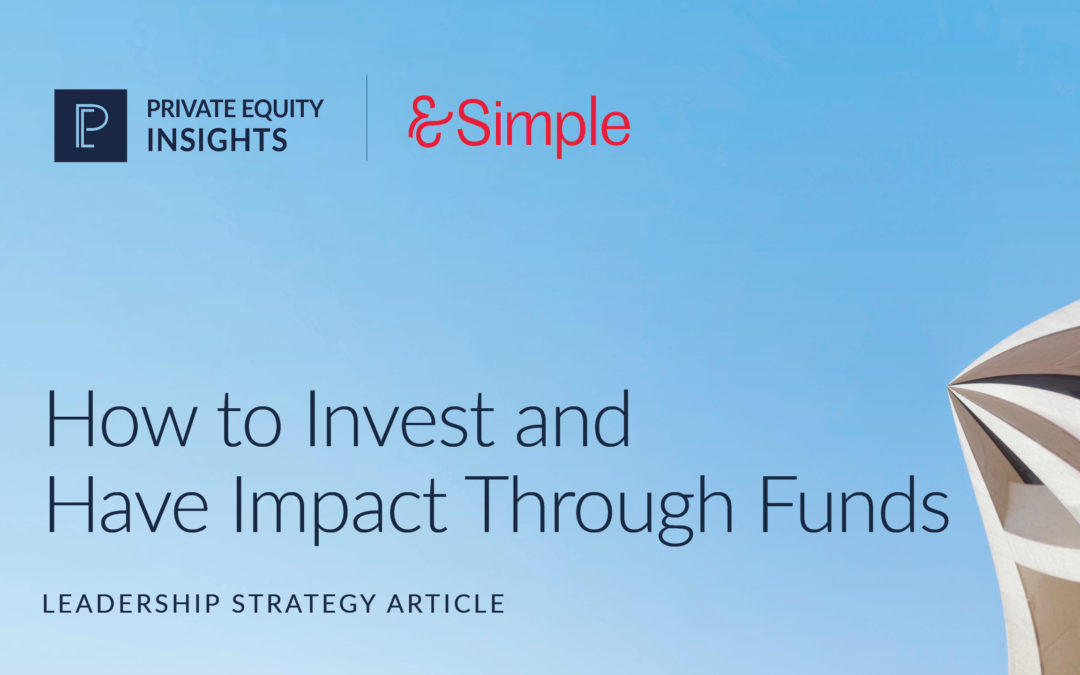Once regarded as a disruptive investment concept, impact investing has evolved into a diverse and intricate investment ecosystem. With this maturation has come the realization that impact investments can yield risk-adjusted, market-rate returns comparable to non-impact ones while also having a positive social or environmental impact. As such, interest in impact investing has grown, and not just in the family office space.
Public pension funds, sovereign wealth groups, university endowments, and other larger institutions are all actively considering their options in this arena, as are many individuals.
According to the Morgan Stanley Institute for Sustainable Investing’s recent report, 85% of investors and 95% of millennials in the United States are interested in sustainable investment options.
While many regard impact investing as a purely direct investment opportunity, few realize that they can put their capital to work in the impact space through managed funds. For those with lesser direct investment expertise, limited access to enough deals, or a lack of time and resources to conduct the burdensome analysis and more in-depth due diligence that impact investments require, funds are an attractive prospect. Recently there’s been a marked uptick in the number of people choosing to invest with funds whose social, environmental, and financial goals match their own.
85% of investors and 95% of millenials in the United States are interested in sustainable investment options.
THINGS TO CONSIDER AND WHAT TO EXPECT FROM IMPACT INVESTMENTS
According to the Global Impact Investing Network (GIIN), impact investments are intended to generate social and environmental impact alongside financial return. When assessed and selected with care, sustainable and impact investments can offer risk-adjusted, marketed related returns while also making a difference. They do, however, require a far greater depth of analysis and due diligence than their non-impact counterparts.
This sentiment is echoed by impact investment advisor, Rachel Browning, “It is difficult to find truly impactful companies that produce positive externalities, help underserved communities or contribute towards solutions. Accessing specialised experts through funds enables investors to access incredible investment opportunities without the same amount of legwork.”
As with any other type of investment, impact results need to be measured in relation to investors clearly defined financial and impact objectives. There is, however, currently no single, unified measurement standard for ESG or impact investing. This makes defining goals and implementing qualitative and quantitative impact measurement metrics throughout the various stages of the business cycle and interpreting the results a complicated practice. It is also one that varies in approach and rigor across various organizations. One of the risks of this is that if a certain level of rigor is not maintained, the label “impact investing” is at risk of becoming diluted and subject to green or rainbow washing, making it merely a marketing tool for those involved.
For this reason, reputable funds, with knowledge and experience in not only administering but applying industry best practices in measuring impact returns, can be indispensable for both individual and institutional investors alike.
“Clearly defining investment timelines, risk appetites and the levels of liquidity required can also aid in identifying the criteria to look for within the various professionally structured products and opportunities on offer. ”
FINDING THE RIGHT FUNDS
When seeking a suitable fund, it is vital for investors first to identify the areas and issues most important to themselves or their organizations. Once this has been considered, the next step is finding a fund that is aligned with these principles. Clearly defining investment timelines, risk appetites and the levels of liquidity required can also aid in identifying the criteria to look for within the various professionally structured products and opportunities on offer. Doing this can help to identify those that are best suited to an investor’s unique investment type.
In addition, it’s vital to understand how funds measure real impact and consider the frameworks used within their reporting. Do they conform to internationally recognized standards? Do they report on the key overall KPIs for each portfolio? Are they relevant and in-line with the investor or institution’s goals? These are just a few of the questions that need to be answered.
For new investors, ImpactBase, a searchable, online database of impact investment funds and products, is an excellent place to start looking for reputable fund managers. Investor communities like Toniic or membership networks like Pymwymic and Social Venture Circle can also help to provide “insider” information and tips gleaned from experience.
Toniic groups funds into spheres and highlights selected funds on their website. In the category of “Financial Services and Emerging Markets” they include Microvest, Sarona and Small Enterprise Assistance Funds. Another category revolves around “Sustainable Agriculture”, and here they highlight Iroquois Valley Farms, Farmland LP and Invest Eco.
Alternatively, attending events like NEXUS or the Opportunity Collaboration (OC) Summit enables investors to connect to credible fund managers in the impact space.
There are also plenty of examples of impact funds in the news these days, like Avenue Capital’s Sustainable Solutions fund that recently saw a $300m commitment from the the New York State Common Retirement Fund’s Sustainable Investments and Climate Solutions program.
Once a potential fund has been identified, investors need to consider its experience and track record carefully. While the impact market is an attractive one, according to Svarrer, starting up a new impact fund or strategy is always difficult. He notes, “The challenge is that it takes a very long time to develop a track record. We are now investing our third private equity fund and have been in the industry for a decade.” He adds, “It is only recently that we have been able to document the results of our team and strategy.”
BEYOND CAPITAL
Impact causes, by nature, require the “additionality” that investors can offer. This is the investor contribution beyond just the capital provided and usually encompasses things like business networks and expertise.
When investing via a fund, it may not be possible for an investor to offer additional value as the contribution is generally only capital. However, this doesn’t mean that this should be overlooked entirely. There is always the option for an investor to approach the organization directly to investigate whether they would be amenable to more than just capital contributions. These could be as an advisory board member or in some other capacity such as supporting the fund’s investments through professional networks.
While no investment can offer only positive impact, it is vital to advance companies and projects that can measure their impact on the environment and society. With carefully considered impact investments, investors no longer have to sacrifice returns to do this.

Francois Botha
FOUNDER OF SIMPLE
“I help family offices and banks solve strategy problems and innovate.”
Can’t stop reading? Read more
Top private equity news of the week
Top private equity news of the week Apollo Global Management has acquired a minority stake in...
Orange’s $5bn move for MásOrange brings Lorca private equity exit into focus
Orange’s $5bn move for MásOrange brings Lorca private equity exit into focus Orange has moved...
Alphabet eyes fresh paper gains as SpaceX valuation reaches $800bn
Alphabet eyes fresh paper gains as SpaceX valuation reaches $800bn Alphabet is poised to record...




